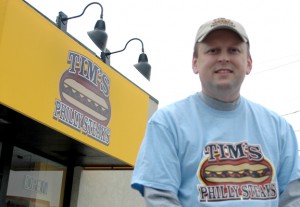
On a Monday in mid-January, Tim Allabashi was on the road to Philadelphia to pick up fresh rolls and other ingredients, with a return trip that same day.
When he promises an authentic Philly cheesesteak, Allabashi means it.
Allabashi has a lot riding on whether sandwich aficionados will go a few miles out of their way to make Tim”™s Philly Steaks in Norwalk part of their lunch “rotation,” as Allabashi put it. A longtime financial sector worker, he self-financed the new store on the “if you build it, they will come” notion.
He is not the only one who sees a need ”“ on the food website Chowhound.com, an entire message string is devoted to perceptions that many Stamford restaurants are woefully lacking in serving up an authentic Philly cheesesteak sandwich.
Allabashi opened Tim”™s Philly Steaks with no previous experience in the food industry, counting on the appeal of the restaurant”™s namesake sandwich and his own work ethic honed over a career in the financial industry, starting as a $200-a-week pit runner in the Chicago Mercantile Exchange after college.
Most recently a systems operations specialist with Graham Capital Management in Norwalk, Allabashi was laid off in 2008 and spent the next few years exploring finance industry opportunities without success before electing to head off in a new direction, self-financing his new restaurant.
“I thought, ”˜what”™s realistic in this economy?”™” Allabashi said. “Cheap food.”
That”™s cheap in concept only ”“ whereas most grills have Philly cheesesteak on the menu, Allabashi says few use the quality ingredients found in the sandwich”™s namesake city: mainly rib-eye steak.
And starting a restaurant is hardly an inexpensive proposition, obviously, and Allabashi says he is mindful of what he has heard is a failure rate of 75 percent or more for new restaurants bandied about in some quarters.
Researchers at Cornell University”™s Center for Hospitality Management actually put the figure closer to 60 percent, at least in the first three years of operation, with 26 percent of restaurants Cornell studied failing in the first year, another 19 percent in the second and 14 percent in the third.
That is still a daunting rate, with factors range from slipshod planning and management; to the ability of nearby chain competitors to outspend independents on marketing; to location, location, location. The biggest contributor to success, on the flip side, is having a distinctive concept that has been well researched.
The Philly cheesesteak, of course, has been extensively researched by connoisseurs dating back to the Depression era, when Pat”™s King of Steaks opened in south Philadelphia, laying claim to this day as the first restaurant to serve the sandwich. Prime competitor Geno”™s Steaks, just across the street from Pat”™s, remain the epicenter of the Philly cheesesteak fanatic”™s universe.
For his own location in faraway Fairfield County, Allabashi said he considered sites within a 20-mile radius of Easton where he lives ”“ as well as New Haven. He took a hard look at Stamford, but felt the rents were too high. Ultimately, he settled on a former Mr. Bagel property a half-mile east of Stew Leonard”™s on Westport Avenue.
“I wanted a place that reminded me what the places are like in Philly, but with the seating,” Allabashi said. “We thought this had a chance to be a destination.”



















